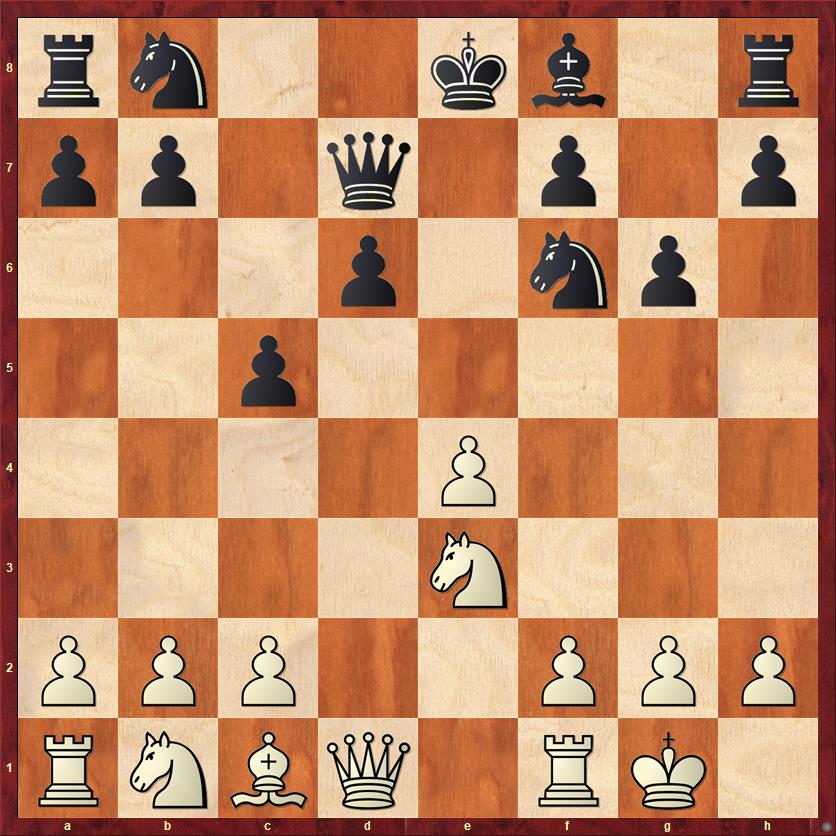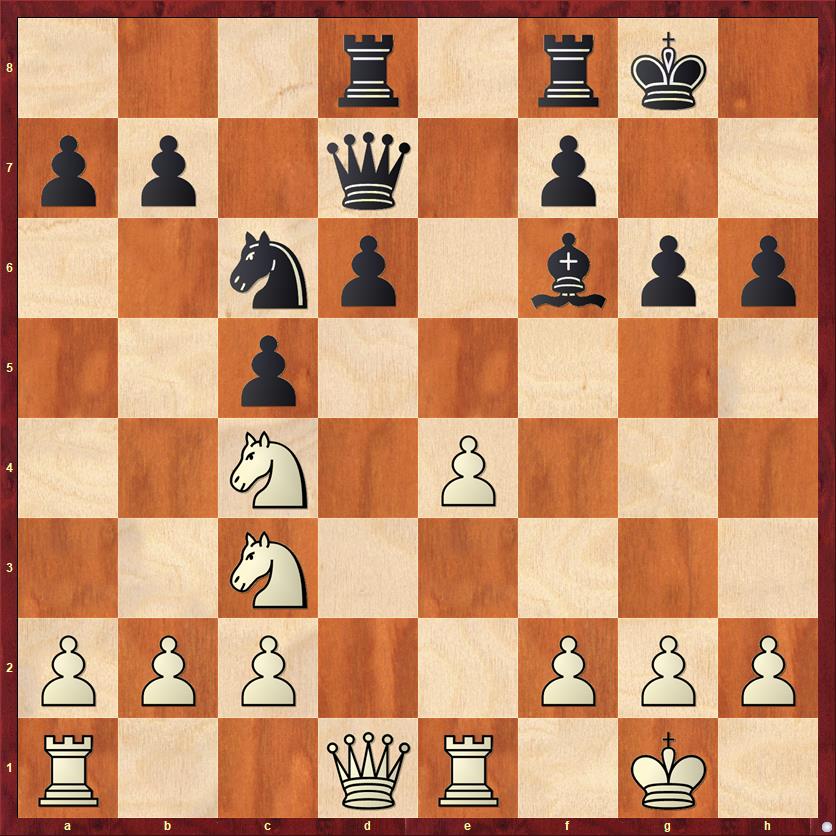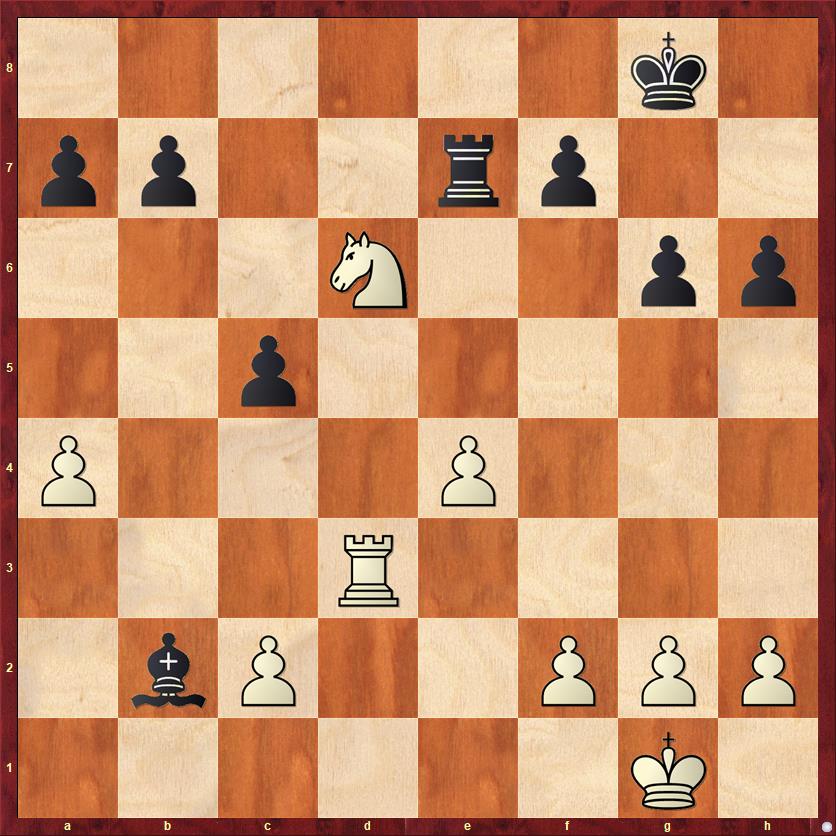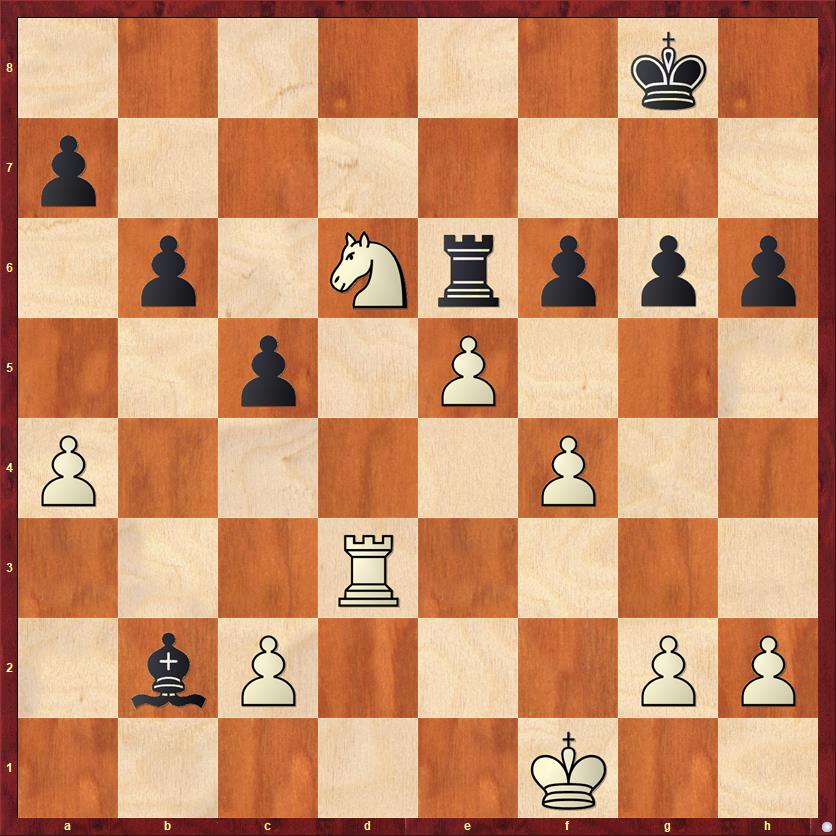This summer and fall I’ve been playing a series of training games with one of my students from the Aptos Library Chess Club, Atlee, who is about 1500 strength (my estimate). Even though I have won all of the games so far, I’ve been quite impressed with his play. His openings are solid, and he shows good ability to form and execute a plan.
Last week we played, in my opinion, our most competitive game yet, one where I had to really work to win. One sign that it’s a good game is that I learned from it, too! It’s a good example of Silman’s theory of dynamic imbalances, where I accept some disadvantages (slower development, knight versus bishop) to obtain other advantages (beautiful outpost for the knights, better pawn structure).
Also there’s some interesting psychology. I feel as if I won, in part, because I disguised my intentions (see moves 24 and 25). Which sets up an interesting discussion: Is it possible to use deception in a game of perfect information, where both sides in theory can see everything that is going on? I think it is possible if you know your opponent and know what things they are likely to see or not see.
Dana — Atlee
1. e4 e5 2. Nf3 d6
Already a surprise! Atlee had never played the Philidor against me before. It worked out surprisingly well for him.
3. d4 ed 4. Nxd4 c5
Creating a backward pawn. But this is not necessarily a bad move! Think, for example, of the Sveshnikov Variation in the Sicilian, where Black also creates a backward d-pawn but gets great piece activity as compensation.
5. Bb5+ Bd7 6. Bxd7+ Qxd7 7. Nf5 g6 8. Ne3 …
My time-consuming knight maneuver was intended to establish firm control over d5. But it also makes me fall behind in development.
8. … Nf6 9. O-O …

FEN: rn2kb1r/pp1q1p1p/3p1np1/2p5/4P3/4N3/PPP2PPP/RNBQ1RK1 b kq – 0 9
The first quiz: Can Black take on e4?
9. … Bg7!
Atlee passes the test! He correctly sniffs out that the e-pawn is poisoned and he loses material after 9. … Nxe4? 10. Nd5 Bg7 11. Re1 f5 12. f3. More generally, I think that his move shows good patience. He realizes that the weakness of my e-pawn will not just go away. If he plays calmly and avoids tactical adventures, sooner or later I’m going to have to defend that e-pawn.
10. Re1 O-O 11. Nc3 Nc6
I was not happy with my position. My pieces are getting in each others’ way; the knight on e3 especially is obstructing the bishop and the rook. So this wandering knight moves once again. Five moves by the same piece in my first twelve moves!
12. Nc4 Rad8?!
A missed opportunity for Black, and an instructive one. The problem with this move is that it is a purely defensive move — kind of a routine, connect-the-dots move — and Black deserves better. The computer comes up with the complicated but strong idea 12. … Qe6! The main point is that 13. Nxd6? would run into a nasty pin with 13. … Rad8. Notice how this move, which is purely defensive on move 12, becomes a strong attacking move if Black sacrifices the d-pawn first.
After 12. … Qe6 I probably would have played the pawn sac 13. Nd5!?, after which the position gets extremely complicated. Without going into deep analysis, let me just say that chess is a battle for the initiative. With 12. … Qe6 Black is fighting for the initiative, trying to make threats so that White has to defend. With 13. Nd5 White refuses to defend and instead makes counterthreats. This is how chess should be played, like a sword fight. Atlee’s move 12. … Rad8 is not a bad move, but it does allow me to take the initiative.
13. Bg5 h6 14. Bxf6 Bxf6

FEN: 3r1rk1/pp1q1p2/2np1bpp/2p5/2N1P3/2N5/PPP2PPP/R2QR1K1 w – – 0 15
This position would be a great one for a class discussion. Was White’s trade of bishop for knight advantageous? I’ve told my students many times that they should not give up a bishop for knight unless they gain some concrete positional benefit from it. Here White has gained an undeniable benefit: the outpost square for his knight on d5. But is that enough?
I think it’s important to admit that I did not know whether White had an advantage here. I suspected that the position was about even. But what’s great about Silman’s theory of dynamic imbalances is that it doesn’t actually matter whether I am “+0.5” or “-0.5”. (Just for the record, Fritz says I’m +0.3.) The way I should play is the same in either case: I should play in a way that emphasizes my advantages while minimizing my disadvantages.
15. Nd5 Bg7 16. a4 Ne7 17. Ra3 …
Almost every move this game leads to an interesting discussion. I thought during the game that my rook lift might be a little bit too extravagant, but it seemed like a nice way to bring the rook to the d-file without moving my queen, which is actually well placed on d1. The computer says that 17. c3 is more accurate. Gjon, my friend who is a National Master and also a chess coach, loved my move and said that “it has Dana written all over it.” True. There is some value to playing moves that are consistent with your personal style, even if they aren’t objectively best.
17. … Nxd5 18. Qxd5 Qe6!
I also like the way that Atlee is playing, which is very much in his style. He clearly has made it his objective to keep trading on d5 until I am forced to take with my pawn. In general I am starting to realize that a major aspect of his approach to chess is to look for what pieces he can trade. This is not a good approach to strategy in general, but in this position it works out pretty well for him.
19. Rd1? …
This move is kind of strange. More consistent is 19. Rd3. I think it’s possible that I had not made up my mind yet whether I wanted my rook on d3 or b3, but I should have made up my mind here.
19. … Qxd5 20. Rxd5 Rfe8
Again a good move, putting pressure on the e-pawn and also hinting at the possibility of a back-rank mate if White isn’t careful.
21. Rxd6!? …
Careful? Who, me? Not on your life!
Seriously, if you just looked at the middle part of this game you would think that White is the 1500 player and Black is the seasoned National Master. I’m playing very close to the brink of disaster. Of course 21. Nxd6? would have failed to 21. … Rxe4! But I really liked the idea of getting the knight to d6, where it both defends and attacks, so I played 21. Rxd6 instead. A calmer and more sensible approach was 21. Re3, defending everything. The principle here is that the weakness on d6 will not go away. I should spend some time protecting my own pawns so that I can then put maximum pressure on Black’s weakness. In the game, we just ended up trading d6 for b2, and I gained no advantage from it.
21. … Rxd6 22. Nxd6 Bxb2 23. Rd3? …
Argh! Again a mistake! Who is this training game for, anyway?
I missed a fairly simple tactical point: after 23. Nxe8! Bxa3 24. Nd6! White wins a pawn outright. The reason is that 24. … b6 runs into 25. Nc8. My reason for missing this was purely psychological: the only continuation I looked at was 24. Nf6+, and I didn’t consider the possibility of just going back the way that I came.
23. … Re7

FEN: 6k1/pp2rp2/3N2pp/2p5/P3P3/3R4/1bP2PPP/6K1 w – – 0 24
For the last nine moves the student has played at least as well as the teacher. But here I came up with a devious plan that really accentuates the difference between human chess and computer chess. I had a sense here that I might be able to trap Black’s bishop with moves like c3, f4, and Nc4. I also had a hunch that Atlee might not see the danger to his bishop until too late. If I begin with some seemingly innocuous moves, like 24. Kf1 (preventing back-rank mates, also stepping out of a potential … Bd4+), he might not see what I’m up to.
24. Kf1 …
Innocuous move number one. The computer, of course, cannot be fooled and it says that 24. … Be5! is good for complete equality. But I’m not playing against a computer. Atlee does not perceive any danger to his bishop and instead thinks the main weakness in his position is the b7 pawn.
24. … b6 25. f4 …
Innocuous move number two, although it’s definitely less innocuous than the last one. There is still time for Atlee to get his bishop out of danger. But he sticks to his plan: he wants to put pressure on my knight. With the rook no longer needed on the second rank, he plays
25. … Re6?
After the game, I thought that this was Atlee’s only mistake (until the last move). There’s still time for him to get the bishop out of trouble with 25. … Bg7. But perhaps he still didn’t realize there was any danger. I can’t play 26. c3 to trap his bishop because 26. … Bxc3! 27. Rxc3 Rxd6 wins a pawn for Black. And he may have thought that my next move was impossible too.
26. e5! f6
I’m sure that he was counting on this move to break down my center and give his bishop an escape hatch. There was one thing he missed.

FEN: 6k1/p7/1p1Nrppp/2p1P3/P4P2/3R4/1bP3PP/5K2 w – – 0 27
27. Nc4! …
There are all sorts of reasons why he might have missed this. Sometimes it’s hard psychologically to realize that a retreat can also be an attack. It’s also sometimes hard to realize that returning a piece to the square it just came from can actually be a good move. Remember that I had the same sort of chess blindness on move 23, when I missed the fact that 23. Nxe8 Bxa3 24. Nd6, returning the knight to the square it just came from, would win a pawn.
27. … Bc1 28. g3 …
Closing the cage around Black’s bishop.
28. … fe 29. Rd8+! …
Surprise! Were you expecting 29. Rd1? That was my original plan, but it’s important to notice that Black can get three pawns for the bishop with 29. … ef! 30. Rxc1 fg 31. hg Re4! After the a-pawn falls, the endgame is by no means a routine win for White, and it may not even be a win at all.
It’s good to be flexible in chess. Here I realized that after 29. Rd8+ I can win a pawn, perhaps two, and turn my rook and knight into the two dominant pieces on the board. That’s much better than the iffy endgame after 29. Rd1.
29. … Kf7 30. Nxe5+ Kf6 31. Rf8+ Ke7 32. Rf7+ Kd6?
Black had to play 32. … Ke8, but after 33. Rxa7 the position looks bleak for him. However, any move is better than walking into mate-in-one. A final lesson for Atlee. A lot of people relax and assume they can’t get checkmated once they get to the endgame. Not so!
33. Rd7 mate
All in all, Atlee played better than I did for most of this game, and I had to pull a rabbit out of the hat to win. That being said, I liked the finish a lot, with the surreptitious trapping of Black’s bishop followed by the sudden switch of attention to Black’s king.
Lessons:
- Chess is a battle for the initiative.
- Nevertheless, there are times when chess calls for patience. For example, when your opponent has permanent weaknesses and you have temporary weaknesses, it may be a good idea to protect your weaknesses first and attack his second. (This is called prophylaxis.)
- Retreating moves can also be attacking moves, and “undoing” a previous move by moving your piece back to the same square can be the right thing to do. Psychologically we tend to underestimate such moves.
- You can’t fool a computer, but you may be able to disguise your intentions against a human.
- Know your own style. A move that creates a type of position that you like may actually be a better choice for you than the move that the computer says is best.
- Even when you have a plan, be flexible and prepared to change your plan if something better comes along.



{ 2 comments… read them below or add one }
(3. Nf3 should be 3. d4)
Instructive way to trap a bishop!
Thanks, Felix, I made the correction.